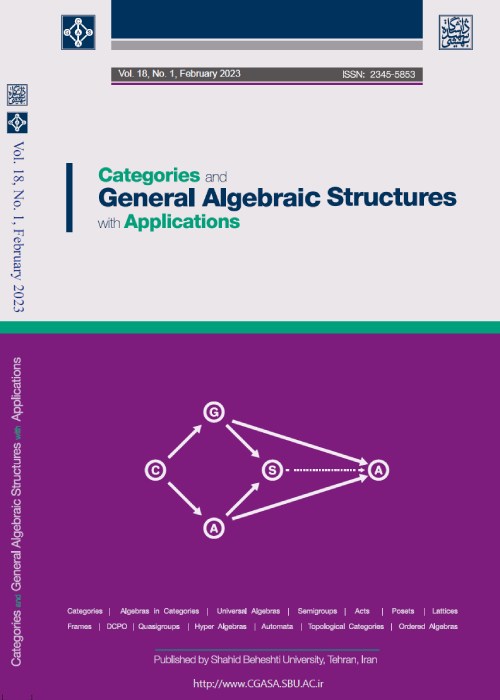فهرست مطالب

Categories and General Algebraic Structures with Applications
Volume:18 Issue: 1, Jul 2023
- تاریخ انتشار: 1402/05/17
- تعداد عناوین: 7
-
-
صفحات 1-18
-
صفحات 19-41
-
صفحات 43-80
-
صفحات 81-103
-
صفحات 105-129
-
صفحات 131-153
-
صفحات 155-223
-
Pages 1-18
The construction of the formal ball model for metric spaces due to Edalat and Heckmann was generalized to Q-categories by Kostanek and Waszkiewicz, where Q is a commutative and unital quantale. This paper concerns the influence of the structure of the quantale Q on the connection between Yoneda completeness of Q-categories and directed completeness of their sets of formal balls. In the case that Q is the unit interval [0, 1] equipped with a continuous t-norm &, it is shown that in order that Yoneda completeness of each Q-category be equivalent to directed completeness of its set of formal balls, a necessary and sufficient condition is that the t-norm & is Archimedean.
Keywords: Q-category, formal ball, continuous t-norm, quantale -
Pages 19-41
In this paper we show that the prime saturated prefilter monads are sup-dense and interpolating in saturated prefilter monads. It follows that CNS spaces are the lax algebras for prime saturated prefilter monads. As for the algebraic part, we prove that the Eilenberg-Moore algebras for saturated prefilter monads are exactly continuous I-lattices.
Keywords: Eilenberg-Moore algebra, prime saturated prefilter monad, saturated prefilter monad -
Pages 43-80
In this paper we define C-induced action graph G(S,a,C;A) corresponding to a semigroup act (S,a,A) and a subset C of S. This generalizes many interesting graphs including Cayley Graph of groups and semigroups, Transformation Graphs (TRAG), Group Action Graphs (GAG), Derangement Action Graphs, Directed Power Graphs of Semigroups etc. We focus on the case when C = S and name the digraph, so obtained, as Action Graph of a Semigroup Act (S, a, A). Some basic structural properties of this graph follow from algebraic properties of the underlying semigroup and its action on the set. Action graph of a strongly faithful act is also studied and graph theoretic characterization of a strongly faithful semigroup act as well as that of idempotents in a semigroup are obtained. We introduce the notion of strongly transitive digraphs and based on this we characterize action graphs of semigroup acts in the class of simple digraphs. The simple fact that morphism between semigroup acts leads to digraph homomorphism between corresponding action graphs, motivates us to represent action graph construction as a functor from the category of semigroup acts to the category of certain digraphs. We capture its functorial properties, some of which signify previous results in terms of Category Theory.
Keywords: Semigroup act, action graph of a semigroup act, strongly transitive digraph, strongly faithful act, free semigroup, equivalence functor -
Pages 81-103
Here, we define (semi)topological L-algebras and some related results are approved. Then we deduce conditions that mention an L-algebra to be a semi-topological or a topological L-algebra and we check some attributes of them. Chiefly, we display in an L-algebra L, if (L, ↠, τ ) is a semi-topological L-algebra and {1} is an open set or L is bounded and satisfies the double negation property, then (L,τ) is a topological L-algebra. Finally, we construct a discrete topology on a quotient L-algebra, under suit- able conditions. Also, different kinds of topology such as T0 and Hausdorff are investigated.
Keywords: L-algebra, ideal, (semi)topological L-algebra, quotient L-algebra, Hausdorff -
Pages 105-129
One of the aims of the modern representation theory is to solve classification problems for subcategories of modules over a unitary ring R. In this paper, we introduce the concept of 1-absorbing comultiplication modules and classify 1-absorbing comultiplication modules over local Dedekind domains and we study it in detail from the classification problem point of view. The main purpose of this article is to classify all those indecomposable 1-absorbing comultiplication modules with finite-dimensional top over pullback rings of two local Dedekind domains and establish a connection between the 1-absorbing comultiplication modules and the pure-injective modules over such rings. In fact, we extend the definition and results given in [17] to a more general 1-absorbing comultiplication modules case.
Keywords: 1-absorbing comultiplication modules, Dedekind domains, non-separated, pure- injective modules, pullback, separated -
Pages 131-153
The aim of this paper is to establish the prime state ideal theorem in state residuated lattices (SRLs). We study the state ideals lattice $\mathcal{SI}(L)$ of a state residuated lattice $(L, \varphi)$ and prove that it is a complete Brouwerian lattice in which the meet and the join of any two compact elements are compact (coherent frame). We characterize the notion of prime state ideals in SRLs. In addition, we establish the condition for which the lattice $\mathcal{SI}(L)$ is a Boolean algebra.
Keywords: State ideal, frame, Residuated lattice -
Pages 155-223
Internal preneighbourhood spaces inside any finitely complete category with finite coproducts and proper factorisation structure were first introduced in \cite{2020}. This paper proposes a closure operation on internal preneighbourhood spaces and investigates closed morphisms and its close allies. Consequently it introduces analogues of several well-known classes of topological spaces for preneighbourhood spaces. Some preliminary properties of these spaces are established in this paper. The results of this paper exhibit that preneighbourhood systems are more general than closure operators and conveniently allows identifying properties of classes of morphisms independent of \emph{continuity} of morphisms with respect to induced closure operators.
Keywords: closure operator, filter, factorisation system, complete lattice, preneighbourhood spaces, complete bounded semilattice

